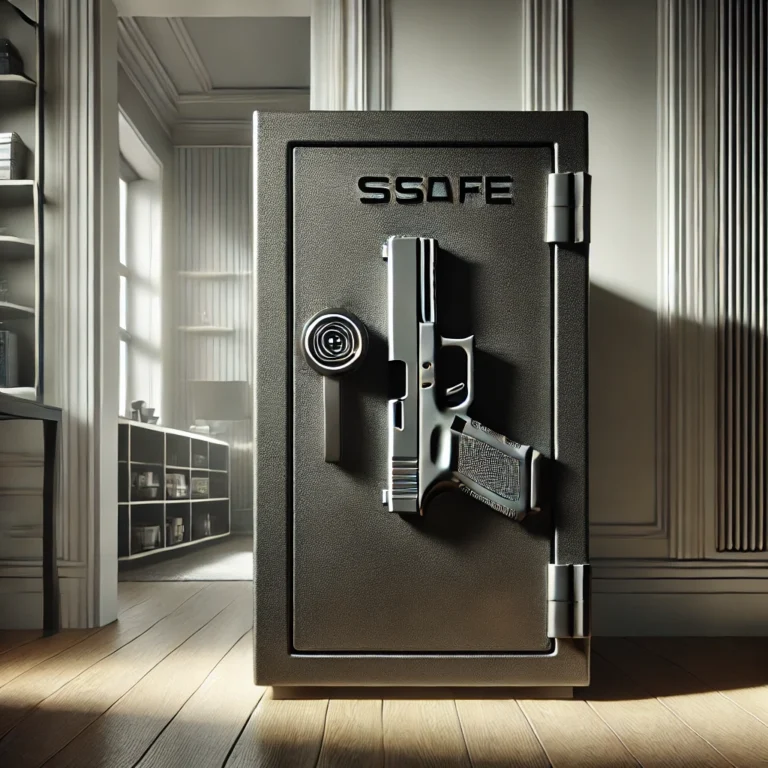Safe and Secure Firearm Storage is not just a responsibility—it’s a necessity for ensuring safety, compliance with laws, and maintaining the longevity of your firearms. Whether you’re an experienced firearm owner or new to handling firearms, understanding the principles and practices of Safe and Secure Firearm Storage will help you avoid accidents, theft, and potential legal troubles. This guide offers comprehensive advice to equip you with the knowledge to store your firearms securely and responsibly.
2. Types of Firearm Safes
Investing in a reliable firearm safe is the cornerstone of Safe and Secure Firearm Storage. Different types of safes offer various features to suit individual needs, including accessibility, size, and security features. Below are the primary options available:
Biometric Safes
- Use fingerprint recognition for quick and secure access.
- Ideal for households with children or where quick access is crucial.
- Many biometric safes also have backup keys for additional reliability.
Combination Safes
- Require a numeric code to unlock.
- Affordable and widely available, offering a balance of security and accessibility.
- Combination locks are less prone to malfunction than electronic options.
Key-Lock Safes
- Traditional safes secured with a key.
- Cost-effective but less convenient for quick access.
- Keys must be stored securely to avoid loss or misuse.
3. Choosing the Right Location for Storage
- Out of Sight: Store safes in inconspicuous areas to deter theft. Hidden compartments, closets, or basements are good options.
- Temperature-Controlled Areas: Prevent moisture buildup that can lead to rust. Use a dehumidifier in areas with high humidity.
- Away from Children: Ensure storage locations are inaccessible to minors. Consider safes with childproof locking mechanisms.
- Emergency Accessibility: Balance security with ease of access in emergencies. Locations like bedrooms or home offices can work well.
4. Firearm Storage Laws and Regulations
Understanding the legal requirements for firearm storage in your region is crucial. Compliance not only ensures safety but also protects you from legal penalties. Some key aspects include:
- Locked Storage: Many states mandate that firearms be stored in locked safes. Some jurisdictions impose penalties for non-compliance.
- Separate Storage for Ammunition: Laws in some regions require storing ammunition separately from firearms. This reduces the risk of misuse.
- Child Access Prevention (CAP) Laws: Non-compliance with CAP laws can lead to legal penalties. Always prioritize child safety when storing firearms.
- Travel Regulations: Firearms transported across state lines often require specific storage protocols, such as unloaded chambers and locked containers.
5. Best Practices for Storing Ammunition
Proper ammunition storage is equally important for maintaining safety and ensuring reliable performance:
- Use Airtight Containers: Protect ammunition from moisture and corrosion. Sealed containers or ammo cans are ideal.
- Label and Organize: Clearly label containers for easy identification. This helps avoid confusion and speeds up retrieval.
- Keep Away from Heat Sources: Avoid storing ammunition near furnaces, heaters, or direct sunlight to maintain its integrity.
- Rotate Stock: Use older ammunition first and keep track of purchase dates to avoid long-term degradation.
6. Firearm Storage for Quick Access
For individuals who require rapid access to their firearms, such as for self-defense, consider these options:
- Nightstand Safes: Perfect for bedside storage with quick open mechanisms. These safes balance security with rapid retrieval.
- Wall Safes: Can be hidden behind pictures or furniture for easy access. Ideal for homeowners seeking discretion.
- Biometric Access: Choose safes with fingerprint recognition for rapid retrieval. Some models include silent entry options for emergencies.
- Dedicated Rooms: Create a secure, dedicated space for firearm storage with quick access options integrated into the design.
7. Maintenance Tips for Firearm Safes
Regular maintenance ensures your firearm safe remains functional and effective:
- Clean Locks and Mechanisms: Use a lubricant to prevent sticking. Avoid over-lubrication, as it can attract dust.
- Check Batteries: Replace batteries in electronic safes regularly. Keep spare batteries nearby for emergencies.
- Inspect for Wear and Tear: Address any signs of rust or damage promptly. Regular inspections extend the life of your safe.
- Test Backup Access: Periodically check backup keys or combination overrides to ensure they function correctly.
8. Common Firearm Storage Mistakes
Avoid these common mistakes to ensure the safety and effectiveness of your firearm storage:
- Leaving Firearms Unlocked: Increases the risk of accidents and theft. Always secure firearms when not in use.
- Improper Placement: Storing safes in damp areas can lead to rust. Use moisture absorbers to combat humidity.
- Neglecting Maintenance: Failing to maintain safes can render them ineffective. Regular upkeep ensures long-term reliability.
- Storing Loaded Firearms: Avoid storing loaded firearms unless specifically required for self-defense. Unloaded firearms are safer for long-term storage.
Frequently Asked Questions (FAQ)
Q: Can I use a standard cabinet for firearm storage?
A: Standard cabinets lack the security features of firearm safes. Always use a purpose-built safe for optimal protection.
Q: What’s the best way to prevent rust on stored firearms?
A: Use a dehumidifier or silica gel packets in your safe to absorb moisture and keep firearms dry.
Q: Should firearms and ammunition be stored together?
A: It’s best to store them separately to comply with laws and enhance safety.
Q: How often should I check my firearm safe?
A: Inspect safes monthly to ensure they’re functioning properly and free from damage or rust.
Q: Are biometric safes reliable?
A: Yes, modern biometric safes are highly reliable and offer quick access. Ensure you choose a reputable brand.
Q: Can I store firearms in a vehicle?
A: While possible, it’s not ideal. Use a portable gun safe and avoid leaving firearms in vehicles for extended periods.
Take the Next Step
Make Safe and Secure Firearm Storage your top priority. Invest in state-of-the-art storage solutions tailored to your needs and ensure peace of mind for you and your family. Start exploring trusted safes and accessories today!

